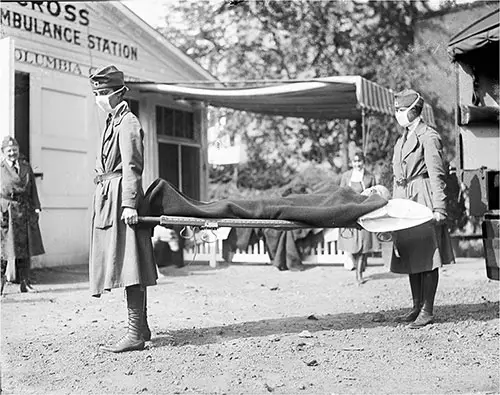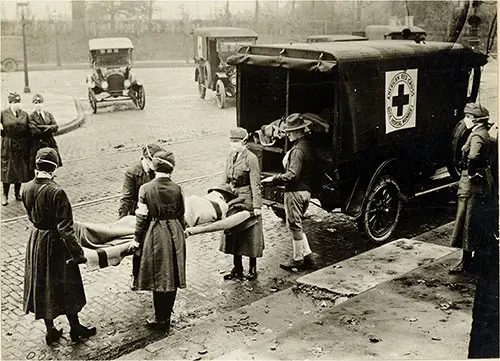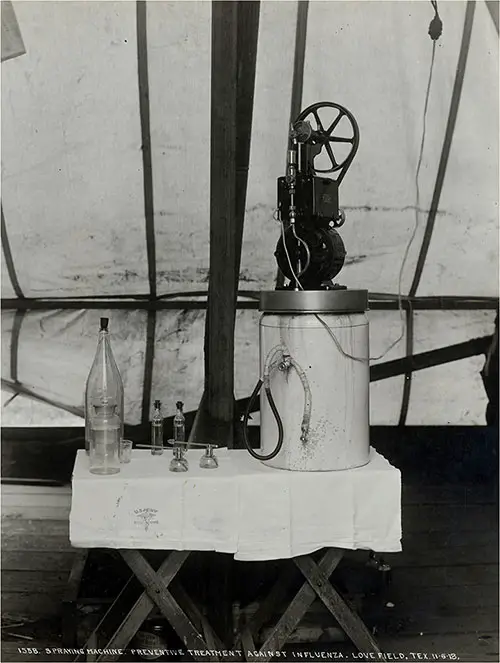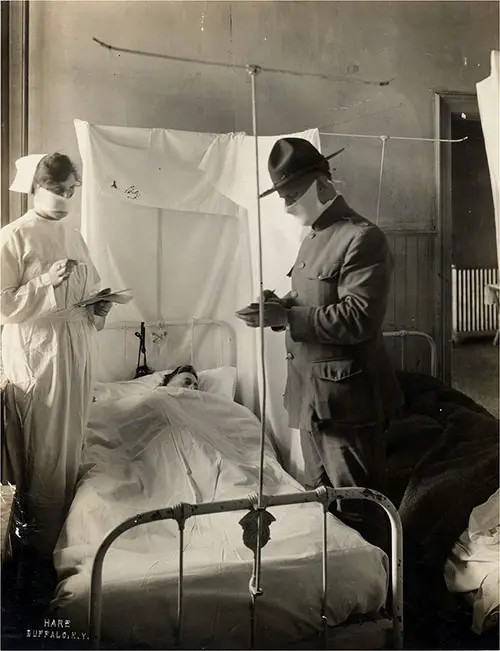Some Statistics of Influenza - 1919

Frederick L. Hoffman, F.S.S., LL. D. (1865-1946). GGA Image ID # 1bd803570d
By Frederick L. Hoffman, LL.D.
Third Vice-President and Statistician of the Prudential Insurance Company of America, Newark, N. J.
Note: Read before the Section on Public Health and Preventive Medicine of the American Medical Association, at Atlantic City, N. J., June 12, 1919. Copyright, William Wood & Company.
The results of our recent investigations are presented to the American Medical Association members in fifty charts that have been reproduced in miniature from the originals shown in the scientific exhibit of the Association.
An attempt is made to visualize the more essential facts of a highly involved mortality problem in these charts. No mere analysis of statistics can lead to valuable results; only a graphic exhibit can visualize the correlation of influenza mortality to season, age, sex, race, locality, etc., in a manner likely to suggest some new or previously unrecognized truth of what is sure to be one of the most important mortality problems of the future.
Influenza Defined

Demonstration at the Red Cross Emergency Ambulance Station in Washington, D.C., During the Influenza Pandemic of 1918. National Photo Company Collection at the Library of Congress. LC # 2016844534. GGA Image ID # 1504ad78c2
There is no satisfactory definition of influenza, and experience has shown that the complications resulting from that place are more fatal in their consequences than the disease itself as a primary cause of death.
As practicable, I have followed the study in comparative statistics of epidemic influenza by F. A. Dixey, M. A., D. M., issued by the Clarendon Press, Oxford, 1892. It is realized that even though the fifty charts presented to the Association represent probably the most comprehensive graphic exhibit in standard form ever made of a single disease in the history of medicine, many more charts will be required before the facts of influenza mortality and its complications, with due regard to age, sex, season, etc., can be thoroughly understood.
However, it is hoped that an opportunity will soon be presented to supplement the exhibit now made with additional charts emphasizing certain aspects brought forward by the discussions of influenza mortality at the recent meeting of the American Medical and kindred associations.
Any effort concerned with the causation of disease must necessarily consider the problem of causation itself. There is much guesswork opinion widely variance with data that cannot be too strongly condemned as amateurish and grossly misleading. In a remarkable essay— "On Causation, With a Chapter on Belief,"—Dr. Charles A. Mercier, the distinguished author of works on "A New Logic,"; "Conduct and Its Disorders,"; "A Text-Book of Insanity,"; "Psychology, Normal and Morbid," etc., contributes an illuminating discussion of the causes of death, which should be read by all who may essay upon the so-called causes or conditioning circumstances of influenza.
It must be sufficient for the present purpose to merely quote Dr. Mercier's remark that Mill's whole treatment of the problem of causation is most deplorable chaos and that he should have been regarded as an oracle for two generations is a startling proof of the poverty of critical understanding and intellectual insight that has prevailed since his logic appeared.
The Causation of Death

Red Cross Motor Corps on Duty St. Louis, Missouri, Circa October 1918. Photograph Courtesy of the American Red Cross. National Archives and Records Administration RG 65-WW-269B-3. NARA ID # 45499293. GGA Image ID # 1508d4b79b
Thus, the canons of causation generally relied upon in philosophical thought are ridiculed and set aside by irrefutable logic and suggestions for reform. Problems as to the causation of death from specific diseases are stated by Mercier as follows:
The cause of death is always a function of two variables—the power acting to maintain the unchanged that we call life and the action or actions that increase the administration's work. The less the power or means of living, the less interference with the life processes necessary to bring life to an end; the more significant the life worthiness, the more powerful must be the interference required to cause death.
To recur to the simile of the clock, the time of death depends on the amount of resilience left in the spring and the amount of friction in the works that one must overcome. If this friction is materially increased at more than one place in the train, then each increase is a different cause of the stopping of the clock.
No conclusions can be sound or far-reaching unless they conform to this method of rigorous thinking and correct interpretation. Influenza is an acute infectious disease due to the Bacillus influenzas originally discovered by Pfeiffer.
Some Causes of Influenza

Gauze Masks Prevent Spreading of Influenza. At the Red Cross Headquarters, Workers Are Busily Engaged in Turning out Gauze Masks to Prevent Spanish Influenza. Soldiers in Many Army Camps Are Wearing Them. Photograph © Underwood & Underwood 3 October 1918. National Archives and Records Administration RG 165-WW-269B-52. NARA ID # 45499393. GGA Image ID # 15074d34e6
The vast experience, however, which has been had during the recent epidemic suggests that even though the Pfeiffer bacillus is the cause of certain forms or types of influenza, it is not, or may not be, the causative factor in others.
Describing acute tracheobronchitis, it is pointed out by Dr. Frederick T. Lord, author of a treatise on the "Diseases of the Bronchi, Lungs, and Pleura," that: An important cause in this group is influenza, the overall picture of which in all epidemics has been that of a respiratory infection, affecting, for the most part, the upper parts of the tract as rhinitis, but in the more severe cases extending to the deeper aspects and even into the smallest branches of the bronchi.
Not a year has elapsed since the great pandemic of 1889-90 without local outbreaks in some parts of the world. The relation between isolated and small infection groups with acute respiratory symptoms occurring in interepidemic periods to epidemics and pandemic influenza is an interesting question that one cannot yet settle.
It is certainly reasonable to assume that in some form, the infecting organism in epidemic and pandemic influenza must be kept alive during the interepidemic period. The contagious character and the similarity of the symptoms in the severer types of the primary acute respiratory infections suggest that these and the influenza cases may be due to a common cause.
As far as the influenza bacillus is concerned, it must be regarded as an essential infecting agent in many acute and chronic disturbances during the interepidemic period and a contributing factor in many other cases when mixed with the pneumococcus, pyogenic cocci, Micrococcus catarrhalis, and other organisms.
The instances in which it exists as a practically pure infection present no striking or consistent difference from the respiratory infection with other microorganisms and without Association with influenza bacilli.
The organism behaves in this respect as any other of the common respiratory parasites. In the interepidemic period, the clinical diagnosis of "influenza" often fails to confirm by finding influenza bacilli in the sputum.
The perplexing confusion is merely increased by statements like those of Dr. R. W. Allen in his treatise on "The Bacterial Diseases of Respiration, and Vaccines in Their Treatment," in which it is said that:
The B. influenza produces the most protean symptoms, but it must be borne in mind that usually associated with it is the pneumococcus. Actual influenza attacks typically result in extreme malaise, headache, joint and muscle pains, and pyrexia, perhaps rigors.

Spraying Machine - A Preventative Treatment Against Influenza at Love Field, Texas, 6 November 1918. National Archives and Records Administration RG 165-WW-269B-2. NARA ID # 45499291. GGA Image ID # 15091ddf11
Before any respiratory symptoms have developed, they may produce a considerable upset in the digestive system. At the same time, the nerves may be so involved that neuritis, diffuse or local, or herpes zoster may appear. In such instances, the infection is probably systemic, subsequently localized in the pulmonary tissues.
Sometimes the disease is confined to the nasal passages and their adnexa and does not extend to the lower respiratory tract; in these instances, infection of the antrum, the ethmoidal, frontal, and sphenoidal cells, and the Eustachian tube is widespread, and while in the majority of cases chronic infection thereof does not result, in a by no means inconsiderable number chronicity does ensue.
Equally suggestive is the statement by Dr. A. P. Beddard, in Allbutt and Rolleston's "System of Medicine," where, concerning bronchial pneumonia, it is said that the primary diseases to which bronchopneumonia is most often secondary are measles, whooping-cough, and bronchitis of the larger tubes, less frequently diphtheria, scarlet fever, acute gastroenteritis, enteric fever, and influenza. Regarding influenza, as has already been pointed out, it is probable that many cases which appear to be primary are influenzas.
Pertinent to this discussion are the views of Dr. P. H. Pye-Smith, in the same work, who, concerning lobar pneumonia, remarks, that in adults, influenza is generally considered to be the disease that most frequently simulates lobar pneumonia.
Influenzas pneumonia is either disseminated pneumonia or bronchopneumonia and differs from lobar pneumonia in its clinical course and physical signs. Lobar pneumonia following influenza has generally been found to be caused by pneumococcus.
In addition to the preceding, the views of Dr. Wade W. Oliver, Professor of Bacteriology, Long Island College Hospital, may be quoted. He remarks, Following the great pandemic of 1890-92, in which persistent search failed to show the presence of Pfeiffer's bacillus.
However, other germs, such as the streptococcus, were found almost, if not entirely, in the sputum of influenza patients. These germs had as much or as little scientific license for being considered the cause of the disease as did the bacillus championed by Pfeiffer. We are given a curiously pertinent insight into the not infrequent orthodoxy of science.
Influenza Statistics
In aid of the cause of truth, The Prudential gives publicity to its scientific research into the statistical facts of influenza frequency, not only as observed during the recent epidemic but also in the great pandemics of the past.
Foremost of the former pandemics, the data of which are of present value, is the outbreak of 1845- 48, or, in a more limited sense, of 1847-48, which afflicted England, particularly the city of London. The most useful descriptive account of this epidemic is the one by Dixey previously referred. The following remarks from his work, however, will be sufficient for the present purpose:
Epidemic of 1847
In the epidemic of 1847, the most noticeable departure from the average mortality is that shown by bronchitis, the deaths from which were in the whole week no less than 779 percent, above the average. Pleurisy follows with a maximum excess of 367 percent.; asthma with 258 percent.; pneumonia, 181 percent.; heart disease, 135 percent.; phthisis, 48 percent.
The highest percentage excess reached by "all causes" was 135. In considering the figures for this epidemic, it must be remembered that they are, to a certain extent, vitiated by the system that then prevailed of dividing the average for the quarter equally among its constituent weeks, the result being that the apparent departure from the mean will often give a very vague impression of the actual amount of the rise or fall.
This especially applies to the mortality from bronchitis. Nevertheless, the figures remain sufficiently striking after a total allowance is made for this source of error.
The fact must not be overlooked, however, as pointed out by Dr. Dixey, that in 1847 the influenza figures, in the words of Dr. Farr, include nearly all the cases in which influenza was returned, whether primary or secondary, in conjunction with other diseases.
Influenza of 1890
In 1890, however, the author stated that only those cases were included in which influenza was returned as the primary cause. Therefore, extreme caution is necessary for comparing past statistics with the present since significant changes in death classification, tabulation, and analysis have been introduced during the intervening years.
Comparative Statistics
Comparing the nonepidemic period of 1845-46 with the epidemic period of 1847-48, the chart clearly shows the excessive mortality from influenza at the older ages, particularly from bronchitis.
The death rates from pneumonia considered by divisional periods of life remain almost the same. In all the charts in which a comparison is made of the mortality from influenza and certain specified acute respiratory diseases, this group's mortality from all conditions almost invariably shows a material rise during years of influenza occurrence in epidemic form.
A careful review of the mortality of selected localities, or, in other words, those for which the data are sufficiently trustworthy, reveals a striking nonconformity or absence of a clearly defined periodicity, etc., in influenza outbreaks in epidemic form.
The two charts exhibiting the mortality from influenza in New York City from 1889- to 1918 are especially suggestive. They show an entire absence of influenza deaths during the first eleven months of 1889, but a sudden rise reaching epidemic proportions during January 1890.
Following this outbreak, there was almost a complete disappearance of influenza deaths until March 1891, the disease again reaching epidemic proportions during the early part of April. After May, the condition practically ceased to occur in New York City until December 1891, when, beginning with a slight rise in mortality, the disease once more reached epidemic proportions in January 1892.
Thus, one can trace the course of the disease during the entire thirty years, or until 1918, when following nearly ten years of only occasional occurrence, but never rising to the proportions of a severe epidemic, except for a suggestive outbreak during the early part of 1916, the disease reappeared during the last week of September 1918 and reached its maximum proportions during the fourth week of October.
Forecasting Future Epidemics

New York City Traffic Cop Wears Gauze Mask for Protection Against Influenza. Photograph © Underwood & Underwood, NY. Taken 16 October 1918. National Archives and Records Administration RG 165-WW-269B-0. NARA ID # 45499301. GGA Image ID # 1507f365a4
Whether the history of medicine and statistics reveals, a more suggestive illustration of the severe error of relying upon so-called experience as a safe forecast for the future may be questioned. Anyone reviewing the influenza mortality statistics of New York City for the last sixteen years might well have reasoned that the disease in epidemic form had practically ceased to exist.
However, the comparatively small outbreaks during the early part of 1916, 1917, and 1918 were all suggestive of a danger almost disregarded by the public health authorities and those engaged in medicine as a healing art.
The close interdependence of influenza and other respiratory diseases fails to suggest their relative importance in public health administration. Heretofore not even pneumonia has received the required amount of highly technical consideration.
The charts for New York City illustrate essential variations in the mortality from pneumonia, which may serve as a suggestive index of future influenza outbreaks.
The mortality from bronchitis was not seriously affected in New York City by the enormous increase in deaths from pneumonia and influenza, as best shown by the chart exhibiting the facts of the epidemic period 1918-19, first for influenza and nontuberculous respiratory diseases combined; and second, for pneumonia and bronchitis.
The same conclusion applies to the chart illustrating the age distribution of the mortality in New York City from specific specified causes, or, in detail, for influenza, bronchitis, and pneumonia. In this chart, an effort is also made to compare the age distribution of deaths from causes stated during the epidemic years 1890-91 and 1918.
It is shown that profound alterations in the age distribution of deaths from influenza occurred, but there were no significant changes in the mortality from bronchitis. The proportion of deaths from pneumonia decreased quite considerably at the younger ages under five, increasing materially at ages 25-44.
A comparison of the monthly death rates from influenza and pneumonia based on the data for the State of Massachusetts, for the periods 1887-92 and 1914-19, also reveals the extraordinary inconsistency in the groups, suggestive of the probability that the epidemic of 1918 was essentially at variance in its main characteristics with the outbreaks of the past.
However, in Massachusetts, the mortality from bronchitis reached a maximum point during the year of the most significant frequency of influenza in 1892. Still, there seems to have been no such increase the mortality from bronchitis during 1918.
However, the mortality statistics for four American cities are even more remarkable, which in some instances show an extraordinary consistency or similarity, but in others, a wide degree of divergence.
In Dayton and Columbus, the disease recurred in severe epidemic form during October 1918, culminating in a second outbreak, practically equivalent in seriousness to the first, in December. In contrast, there seems to have been no such recurrence in Pittsburgh in Cleveland. During the first epidemic, the maximum frequency rate was not attained again during the second.
These are merely illustrations of the charts made available for the information of the medical profession and of which one can have copies on application to The Prudential. Those who may wish to reproduce the charts will be provided with electrotypes, and we hope to be able to furnish lantern slides to those who can use such reproductions for lecture purposes.
Loss of Life from Influenza and Pneumonia

Volunteer Red Cross Nurses Care for Influenza Cases at Barracks Hospital When Epidemic Hits the School at S.A.T.C. Colorado Agricultural College, Fort Collins, Colorado. Photograph by O. J. Watrous Circa 1918. National Archives and Records Administration RG 165-WW-102L-13. NARA ID # 26425505. GGA Image ID # 150e5e4822
It is conservatively estimated that the mortality from influenza and pneumonia caused a loss of approximately 400,000 lives last year. If an allowance is made for the average mortality, which would have occurred from bronchial and other forms of pneumonia and other diseases complicated by influenza, the excess in the mortality was undoubtedly not less than 300,000.
Based on a conservative estimate, the average death rate was increased by 20 percent by the influenza epidemic. It is a foregone conclusion that there will be a recurrence of the epidemic, the severity of which will depend mainly upon its collateral effects on other diseases.
Therefore, further study and analysis of the available data concerning influenza are urgently called for by the vast importance of the disease to the American people.
As observed by Dixey, among the disorders the mortality from which is carried up with the rise of influenza, those of the respiratory system, especially bronchitis and pneumonia, hold the top place. Phthisis and diseases of the organs of circulation were primarily affected, while the number of deaths attributed simply to old age undergoes a marked increase. Besides being fatal to the 'asthmatic,' Dr. Farr has pointed out that the epidemic of 1847 caused a rise in whooping cough, measles, and typhus. ...
It has been asserted that the prevalence of influenza has, at least in some cases, led to a significant increase in the number of deaths due to premature birth. The epidemic of influenza and its numerous resulting problems clearly emphasizes the importance of a new system of death classification, which shall include at least the secondary causes of death.
The so-called Budapest death classification system offers the only solution to a difficulty that will continue to perplex those who want to know the influenza problem's whole truth. Adopting the Budapest system of dual classification is neither difficult nor expensive.
Still, once in general use, it will aid the entire cause of preventive medicine, public health, and medicine as a healing art materially. These and many other improvements in statistical practice are urgent requirements for understanding disease prevalence and causation, which brings us nearer to the ultimate truth.
Pneumonia in Army Camps

Spanish Influenza in Army Hospitals. Masks and Cubicles Used in United States of America General Hospital Number 4, Fort Porter, New York. Patients' Beds Are Reversed, Alternately, so Breath of One Patient Will Not Be Directed Toward the Face of Another. Photo circa 19 November 1918. National Archives and Records Administration RG 165-WW-269B-4. NARA ID # 45499295. GGA Image ID # 1507797886
Of particular value in connection with the preceding is the following concluding sentence from an exceedingly important report on "Pneumonia in Army Camps," by Dr. William G. McCallum, issued on April 16, 1919, by the Rockefeller Institute for Medical Research.
Referring to the significance of the presence of influenza bacilli in pneumonia, it is said:
Whatever its actual status in connection with the epidemic disease, influenza, we have at least learned from numerous autopsies that it must be regarded as a severe pathogenic agent in the production of pneumonia and that one may find it in the pure culture associated with a form of pneumonia which is practically identical with the interstitial bronchopneumonia described above, except in the absence of empyema.
It is, however, often found with pneumococci and streptococci in other types of pneumonia. one must recognize that the interstitial forms of bronchopneumonia can be produced by various organisms, including pneumococci streptococci and the influenza bacillus.
Where there is a mixed infection, it is difficult to assign each its exact part in the process. Still, it appears that, despite the frequent presence of the influenza bacillus, this was essentially an epidemic of streptococcal pneumonia.
Thus, one scientific investigation after another finds a solution to the problem only further removed. As pointed out in an account of the "Origin, Symptoms, and Cure of the Influenza or Epidemic Catarrh," published in Philadelphia in 1832, It is to the dread of the disease, of its vagueness and obscurity, that every effort to elucidate the facts of influenza occurrence in epidemic form is a welcome addition to the ultimate cause of truth. There is as much danger in the ready acquiescence to influenza occurrence as in the fatalistic attitude regarding other disease factors common to modern life.
Dr. Peter Irving, in an essay entitled "An Inaugural Dissertation on Influenza" published in the City of New York in 1794, introduced the subject with what properly makes a concluding sentence to these few remarks:
It is an old and well-established adage that custom reconciles all things. The universal prevalence of evil has long since habituated the world to its uncomfortable effects.
The disease itself, though always an unwelcome visitor, has become an old acquaintance; and those complaints, not generally fatal, which are most common, are at length so familiarized to our ideas by the frequency of their occurrence that, while absent, they are rarely dreaded and, when felt, are commonly disregarded.
FREDERICK L. HOFFMAN, F.S.S., LL. D.
Third Vice President and Statistician The Prudential Insurance Company of America, Fellow American Statistical Association, Fellow Royal Statistical Society, Honorary Member Actuarial Society of Switzerland, Member International Actuarial Congress, Associate Fellow American Medical Association, Member American Association for the Advancement of Science, Member Executive Committee National Civic Federation, etc.
For Further Study
*Since he wrote this paper, there have been several significant contributions to the statistical study of influenza, particularly some unique:
Tables of Mortality from Influenza and Pneumonia in Indiana, Kansas, and Philadelphia, published by the Bureau of the Census, Washington, 1920.
Influenza Mortality among Wage-earners and their Families, by Frankel and Dublin, American Journal of Public Health, October 1919.
Special Report No. 36 of the Medical Research Committee, London, 1919, on "Studies of Influenza in Hospitals of the British Army in France," 1918. price 3s. 6d., net, obtainable through P. S. King & Son, Great Smith Street, London.
Report on the Mortality from Influenza in Scotland during the Epidemic of 1918-1919, Supplement to the Annual Report of the Registrar General for Scotland, Edinburgh, 1919. price 3d.
"The 1918 Pandemic of Influenza in Canton, China," Bulletin No. 22, Canton Christian College, Canton, China.
